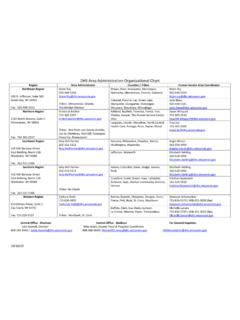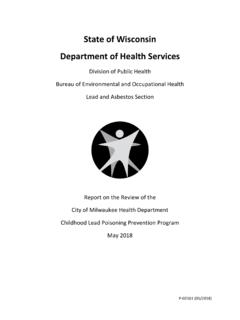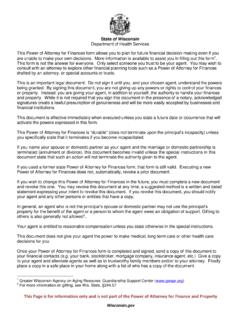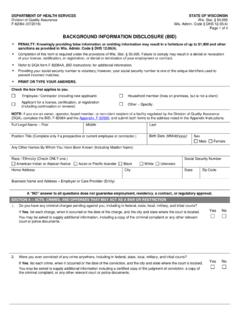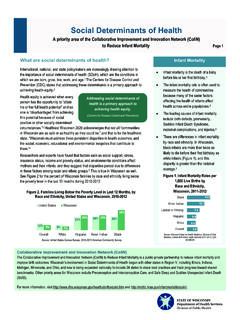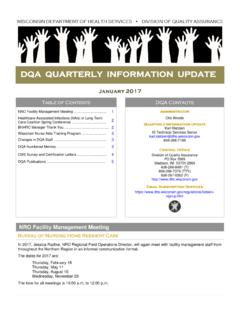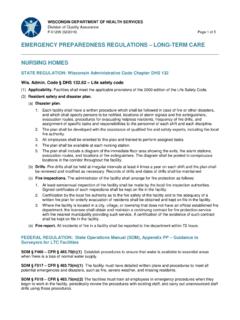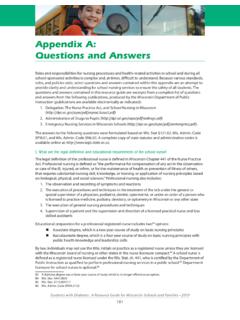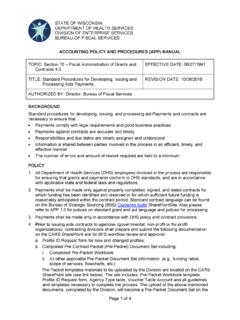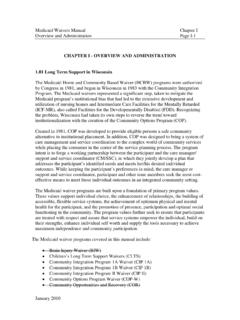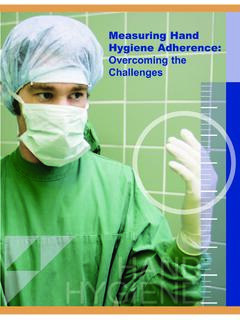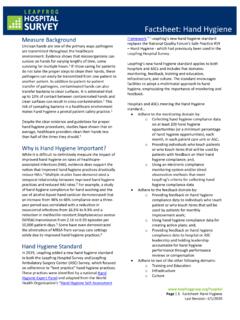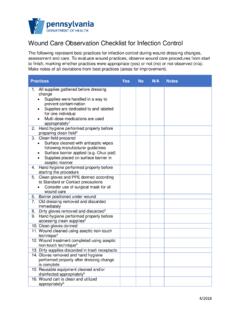Transcription of CDC and WHO Guidelines for Hand Hygiene
1 01/29/2020. CDC and WHO Guidelines and How They Relate to Long Term Care Facilities John M. Boyce, MD. Boyce Consulting, LLC. Middletown, CT. Disclosure: JMB is a consultant to, has received travel support from, and has been a speaker at conferences supported by Diversey and GOJO industries 1. CDC and WHO Guidelines and How They Relate to Long Term Care Facilities Background Timeline of CDC and World Health Organization (WHO) Guidelines Compare CDC and World Health Organization Guidelines CDC recommendations on when to perform hand Hygiene Comparison of recommendations by CDC and WHO Guidelines What's different in 2014 SHEA Compendium on hand Hygiene 2019 CDC training course recommendations for hand Hygiene in nursing homes 2.
2 CDC and WHO Guidelines and How They Relate to Long Term Care Facilities Evidence supporting the use of ABHRs as the preferred method of hand Hygiene Less time consuming Antimicrobial efficacy Less irritating and drying than soap and water handwashing Recommended methods for applying ABHRs to hands Amount to apply Cover all surfaces of hands /fingers How long should you rub your hands together? What are the WHO's 5 Moments for Hand Hygiene . Describe 5 Moments Explain Patient Zone How do the 5 Moments relate to LTCFs Summary 3. 1. 01/29/2020. CDC Guideline for Hand Hygiene in Health Care Settings Major recommendations: Alcohol based hand rub (ABHR). was recommended as the preferred form of hand Hygiene if hands are not visibly soiled Indications for when to wash with with soap and water were included Educate healthcare workers (HCWs).
3 Regarding the advantages of ABHRs Monitor hand Hygiene compliance of HCWs and provide them with feedback on their performance Boyce JM & Pittet D et al. MMWR 2002;51 (RR 16):1 45 4. 2002 CDC Guideline for Hand Hygiene in Healthcare Settings Recommendations are for acute care and LTCFs No specific recommendations for LTCFs Wash hands with a non-antimicrobial soap and water or with an antimicrobial soap and water: When hands are visibly dirty or contaminated with proteinaceous material, or are visibly soiled with blood or other body fluids (IA). Before eating (IB). After using a restroom (IB). If exposure to Bacillus anthracis is suspected or proven (II). Boyce JM, Pittet D et al. MMWR 2002;51(RR 16):1 45 5.
4 2002 CDC Guideline for Hand Hygiene in Healthcare Settings If hands are not visibly soiled, use an alcohol-based hand rub for routinely decontaminating hands Before contact with the patient and before performing aseptic procedures ( , starting IV, inserting Foley catheter). After contact with a patient's intact skin (IB). After contact with body fluids or excretions, mucous membranes, non-intact skin and wound dressings (IA). If moving from a contaminated body site to a clean body site during patient care (II). After contact with inanimate objects (including medical equipment) in the immediate vicinity of the patient (II). After removing gloves (IB). Boyce JM, Pittet D et al. MMWR 2002;51(RR 16):1 45 6.
5 2. 01/29/2020. 2009 WHO Guidelines on Hand Hygiene in Health Care Developed by > 100. international experts General recommendations None specific for LTCFs Indications for hand Hygiene are very similar to those in CDC guideline 7. Comparison of CDC and WHO Hand Hygiene Guidelines *. Ellingson K et al. Infect Control Hosp Epidemiol 2014;35:937 (SHEA Compendium). 8. 2014 SHEA Practice Recommendation on Hand Hygiene SHEA document was designed to: Present a more concise (shorter) format than CDC and WHO. Update the evidence base supporting recommendations Identify issues that require clarification or greater research Differences between CDC, WHO and SHEA documents SHEA agrees with WHO that either non antimicrobial soap or antimicrobial soap can be used for handwashing (unlike CDC).
6 Both SHEA and WHO recommend hand Hygiene before preparing or handling medication during patient care (not in CDC guideline). SHEA document recommends monitoring hand Hygiene using: Direct observation Product volume measurement ( number of liters of ABHR used/100 resident yrs). Automated monitoring system (not in CDC or WHO Guidelines ). Ellingson K et al. Infect Control Hosp Epidemiol 2014;35:937. 9. 3. 01/29/2020. 2014 SHEA Practice Recommendation on Hand Hygiene Differences between CDC, WHO and SHEA documents Unlike CDC and WHO, SHEA recommends Consider preferential use of soap & water handwashing during norovirus outbreaks Based evidence that some ABHR formulations have reasonable activity against norovirus (hence the use of such products on cruise ships).
7 During C. difficile outbreaks or settings with hyperendemic C. difficile, Consider preferential use of soap & water handwashing after caring for patients with known or suspected C. difficile infection Wearing gloves is the primary form of hand Hygiene when caring for residents with C. difficile infection Do not use triclosan containing soap (unlike CDC and WHO). Ellingson K et al. Infect Control Hosp Epidemiol 2014;35:937. 10. Evidence Supporting the Use of ABHRs as the Preferred Method of Hand Hygiene Time required for soap & water handwashing: 62 seconds to get to sink, wash, dry and return ICU with 12 nurses 40% compliance: 2 to hrs/8 hr shift 100% compliance: 16 hrs/shift Time required for alcoholic hand disinfection: 15 second contact time bedside dispenser 40% compliance: 1 to hrs/8 hr shift 100% compliance: 4 hrs/shift Voss A & Widmer AF Infect Control Hosp Epidemiol 1997;18:205 8 11.
8 Attitudes of Healthcare Workers in the United States about Alcohol Hand Rubs A few countries in Europe and Scandinavia were using alcohol based hand rubs (ABHRs) for hand Hygiene in the 1980s and 1990s However, in the , there was a widespread belief among healthcare workers that : alcohol will dry out my hands . 4. 01/29/2020. 13. Relative Efficacy of Hand Hygiene Agents Page 1 of 1 Least Effective Most Effective Year 1 2 3 4 5 6. 1965. 1975. 1978. 1978. 1979. 1980. 1980. 1982. 1983. 1984. 1985. 1986. 1986. 1988. 1991. 1991. 1992. 1992. 1994. 1999. 1999. 1999. Soap HCP CHG Alcohol PCMX Triclosan Iodophor Alc/CHG. JMBoyce 14. Contamination of HCW Bare Hand After Touching Patient Colonized with MRSA.
9 Before Hand Hygiene After Use of Alcohol Hand Rub 15. Donskey CJ et al. N Engl Jmed 2009;360:e3. 5. 01/29/2020. Efficacy of Soap & Water Handwashing vs Alcohol Based Handrub in Reducing Pathogens on the hands of LTCF Personnel Mody L et al. Infect Control Hosp Epidemiol 2003;24:165 16. Irritant Contact Dermatitis Due to Frequent Handwashing Frequent use of soap & water can lead to skin irritation and damage due to irritant contact dermatitis Painful skin irritation causes healthcare personnel to avoid handwashing May lead to increased colonization of hands by pathogens 17. Alcohol Based Hand Rubs Cause Less Skin Irritation and Dryness than Soap & Water Handwashing In 1998, a 6 week prospective randomized trial with crossover design Funded by GOJO Industries 29 nurses on 3 wards participated The study compared: a non medicated, mild soap an alcohol hand gel Skin irritation/dryness of nurses hands were assessed: self assessment by participants visual assessment by study nurse measuring electrical capacitance of skin on hands Boyce JM et al.
10 Infect Control Hosp Epidemiol 2000;21:442 18. 6. 01/29/2020. Average Electrical Capacitance Readings of the Skin of Nurses' hands 28. Mean Corneometer Reading 26. 24. 22. P = 20. 18 Soap 16 Alcohol Gel 14. 12 N = 29. 10. Baseline Middle Final Note: Low Corneometer reading indicates dry skin Boyce JM et al. Infect Control Hosp Epidemiol 2000;21:442 19. HAND Hygiene COMPLIANCE. DURING 7 HOSPITAL WIDE SURVEYS, UNIVERSITY OF GENEVA HOSPITALS, 1994 97. 100. Hand disinfection 90. Percent Compliance Handwashing 80. 70. 60. 50. 40. 30. 20. 10. 0. 1 2 3 4 5 6 7. Pittet D et al. Lancet 2000;356:1307. 20. Prevalence of Nosocomial Infections and Incidence of MRSA, University of Geneva Hospitals, 1993 98. 20. Nosocomial Infections/100 Adm 18.
